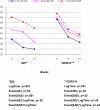Predictors of spontaneous and systematically assessed suicidal adverse events in the treatment of SSRI-resistant depression in adolescents (TORDIA) study
- PMID: 19223438
- PMCID: PMC3593721
- DOI: 10.1176/appi.ajp.2008.08070976
Predictors of spontaneous and systematically assessed suicidal adverse events in the treatment of SSRI-resistant depression in adolescents (TORDIA) study
Erratum in
-
Corrections to Kennard et al., Pham et al., Brent et al.Am J Psychiatry. 2019 Sep 1;176(9):764. doi: 10.1176/appi.ajp.2019.1769correction. Am J Psychiatry. 2019. PMID: 31474123 No abstract available.
Abstract
Objective: The authors sought to identify predictors of self-harm adverse events in treatment-resistant, depressed adolescents during the first 12 weeks of treatment.
Method: Depressed adolescents (N=334) who had not responded to a previous trial with an SSRI antidepressant were randomized to a switch to either another SSRI or venlafaxine, with or without cognitive behavior therapy. Self-harm events, i.e., suicidal and non-suicidal self-injury adverse events were assessed by spontaneous report for the first 181 participants, and by systematic weekly assessment for the last 153 participants.
Results: Higher rates of suicidal (20.8% vs. 8.8%) and nonsuicidal self-injury (17.6% vs. 2.2%), but not serious adverse events (8.4% vs. 7.3%) were detected with systematic monitoring. Median time to a suicidal event was 3 weeks, predicted by high baseline suicidal ideation, family conflict, and drug and alcohol use. Median time to nonsuicidal self-injury was 2 weeks, predicted by previous history of nonsuicidal self-injury. While there were no main effects of treatment, venlafaxine treatment was associated with a higher rate of self-harm adverse events in those with higher suicidal ideation. Adjunctive use of benzodiazepines, while in a small number of participants (N=10) was associated with higher rate of both suicidal and nonsuicidal self-injury adverse events.
Conclusions: Since predictors of suicidal adverse events also predict poor response to treatment, and many of these events occurred early in treatment, improving the speed of response to depression, by targeting of family conflict, suicidal ideation, and drug use may help to reduce their incidence. The relationship of venlafaxine and of benzodiazepines to self-harm events requires further study and clinical caution.
Figures
Comment in
-
Teenaged, depressed, and treatment resistant: what predicts self-harm?Am J Psychiatry. 2009 Apr;166(4):385-7. doi: 10.1176/appi.ajp.2009.09020265. Am J Psychiatry. 2009. PMID: 19339360 Free PMC article. No abstract available.
-
Potential limitations in generalizing findings from the TORDIA study.Am J Psychiatry. 2009 Aug;166(8):935-6; author reply 936-7. doi: 10.1176/appi.ajp.2009.09050639. Am J Psychiatry. 2009. PMID: 19651754 No abstract available.
-
TORDIA: unique opportunity to explore half-life theory.Am J Psychiatry. 2009 Aug;166(8):936; author reply 936-7. doi: 10.1176/appi.ajp.2009.09050601. Am J Psychiatry. 2009. PMID: 19651756 No abstract available.
References
-
- Bridge J, Iyengar S, Salary CB, Barbe RP, Birmaher B, Pincus H, Ren L, Brent D. Clinical response and risk for reported suicidal ideation and suicide attempts in pediatric antidepressant treatment: a meta-analysis of randomized controlled trials. JAMA. 2007;297:1683–1696. - PubMed
-
- Libby AM, Brent DA, Morrato EH, Orton HD, Allen R, Valuck RJ. Decline in treatment of pediatric depression after FDA advisory on risk of suiciality with SSRIs. Am J Psychiatry. 2007;164:884–891. - PubMed
-
- Gibbons RD, Brown CH, Hur K, Marcus SM, Bhaumik DK, Erkens JA, Herings RMC, Mann JJ. Early evidence on the effects of regulators’ suiciality warnings on SSRI prescriptions and suicide in children and adolescents. Am J Psychiatry. 2007;64:1356–1363. - PubMed
-
- Apter A, Lipschitz A, Fong R, Carpenter DJ, Krulewizc S, Davies JT, Wilkinson C, Perera P, Metz A. Evaluation of suicidal thoughts and behaviors in children and adolescents taking paroxetine. J Child Adolesc Psychopharmacology. 2006:16–77. - PubMed
Publication types
MeSH terms
Substances
Grants and funding
LinkOut - more resources
Full Text Sources
Other Literature Sources
Medical




